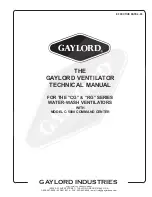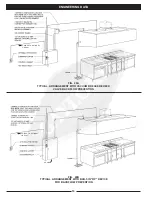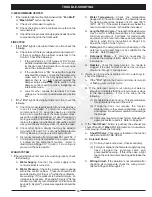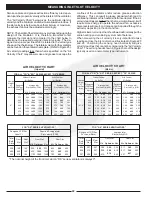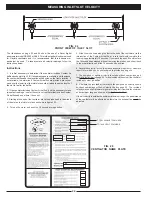
DAILY OPERATION
All functions of the ventilator, such as starting the exhaust fan,
starting the wash cycle, etc., are controlled by the Command
Center located on the control cabinet. Refer to Pages 13
through 15 for detailed instructions on the operation of the
Command Center.
Starting the Exhaust Fan
To start the exhaust fan push the “Start Fan” button on the
Command Center. If the Command Center is equipped with a
time clock (“TC” Series control), it may be programmed to start
automatically at any desired time. (Refer to programming
instructions on Page 15 for automatic operations.) The “Fan
On” light will illuminate when the exhaust fan is running. It is
important to start the exhaust fan before turning on the cooking
equipment.
Stopping the Exhaust Fan and
Starting the Wash Cycle
CAUTION: The cooking equipment must be shut off prior to
shutting off the exhaust fan. Failure to do this will cause
excessive heat buildup and could cause the surface fire
protection system to discharge.
1.
To start the wash cycle push the “Start Wash” button
on the Command Center. If the Command Center is
equipped with a time clock (“TC” Series control), it may be
programmed to start automatically at any desired time.
Refer to programming instructions on Page 15 for auto-
matic operations. When the wash cycle is activated the
“Wash On” light illuminates and the following occurs:
A. The exhaust fan shuts off.
B. Hot detergent water is automatically released into the
interior of the ventilator for the length of time set on the
wash timer. The length of the wash cycle may be set
for 3 different wash times, 3 minutes for light-duty
equipment, 5 minutes for medium-duty equipment,
and 9 minutes for heavy-duty equipment.
FIG. 14
VENTILATOR CONTROL CABINET
MODEL GPC-5000 SERIES
9
DAILY OPERATION
However, adequate cleaning is dependent upon water
pressure, water temperature, daily grease accumula-
tion, the length and frequency of the wash cycle, and
the type of detergent being used. Refer to wash timing
instructions on Page 14 for setting the length of the
wash cycle.
NOTE: Some control cabinets are equipped with a
low detergent switch. If so equipped, the “Wash On”
light will flash if the detergent tank is empty or if the
detergent pump is malfunctioning and detergent is not
pumping.
2.
After the wash cycle is completed, wipe the exposed front
surface of the baffle at the air inlet of the ventilator, as well
as other exposed exterior surfaces. (Refer to Figure 15)
3.
The ventilator is now clean. The exhaust fan may be
restarted by pushing the “Start Fan” button on the
Command Center.
In very heavy cooking operations it may be necessary to wash
the ventilator(s) more than once a day. If equipped with a time
clock (Model C-5000-TC Series) the Command Center is
capable of being programmed to start the wash cycle several
times within a 24-hour period. Refer to programming instruc-
tions on Page 15.
NOTE: For proper operation of the wash system:
Water Pressure
40 psi min. - 80 psi max.
(2.8Kg/cm
2
- 5.6Kg/cm
2
)
Water temperature
140°F min. - 180°F max.
(60°C min. - 82°C max.)
NOTE: The ventilator wash system is designed to remove daily
accumulations of grease within the extraction
chamber. If the ventilator is not washed a minimum of once
during a cooking day, a grease buildup could accumulate
which the wash system cannot remove. If this occurs, it is
recommended that the ventilator be put through several wash
cycles by pushing the “Start Wash” button on the Command
Center. If this does not remove the grease, it will be necessary
to remove the grease manually by using a scraping tool, such
as a putty knife, or retain the services of a commercial hood
cleaning service to steam clean or pressure wash the system.
WARNING: Some commercial hood cleaning services blow
a fire retardant chemical into hood and duct systems. Fire
retardant chemicals should never be applied to any portion of
The Gaylord Ventilator. If retardant is applied to the ventilator,
it must be removed.
COMMAND CENTER
MODEL C-5000
SERIES
Summary of Contents for CG Series
Page 34: ...32 DETERGENT PUMP ...
Page 35: ...33 MISCELLANEOUS VENTILATOR PARTS ...
Page 36: ...34 WIRING DIAGRAM FOR GPC 5000 WITH ELECTRIC FIRE DAMPER 120 VOLT ...
Page 37: ...35 WIRING DIAGRAM FOR GPC 5000 WITH FUSE LINK FIRE DAMPER 120 VOLT ...
Page 38: ...WIRING DIAGRAM FOR GPC 5000 S5 WITH ELECTRIC FIRE DAMPER 120 VOLT 36 ...
Page 39: ...WITH FUSE LINK FIRE DAMPER 120 VOLT WIRING DIAGRAM FOR GPC 5000 S5 37 ...
Page 40: ...WIRING DIAGRAM FOR GPC 5000 WITH ELECTRIC FIRE DAMPER 220 VOLT 38 ...
Page 41: ...WITH FUSE LINK FIRE DAMPER 220 VOLT WIRING DIAGRAM FOR GPC 5000 39 ...
Page 42: ...WIRING DIAGRAM FOR GPC 5000 S5 WITH ELECTRIC FIRE DAMPER 220 VOLT 40 ...
Page 43: ...WITH FUSE LINK FIRE DAMPER 220 VOLT WIRING DIAGRAM FOR GPC 5000 S5 41 ...
Page 46: ......

